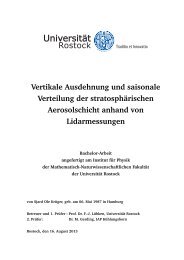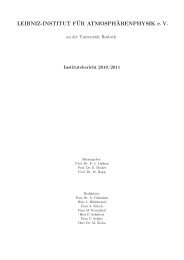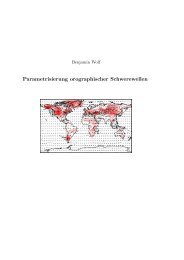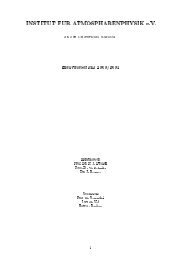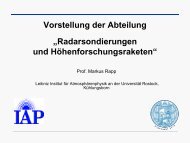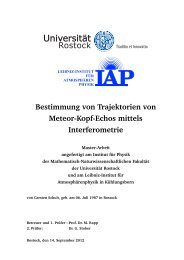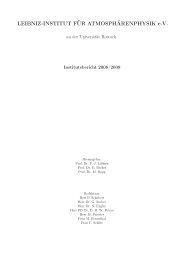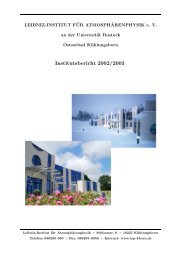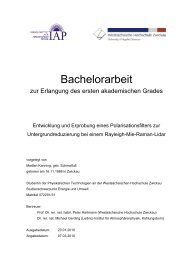Polar mesosphere summer echoes (PMSE): review of ... - HAL
Polar mesosphere summer echoes (PMSE): review of ... - HAL
Polar mesosphere summer echoes (PMSE): review of ... - HAL
You also want an ePaper? Increase the reach of your titles
YUMPU automatically turns print PDFs into web optimized ePapers that Google loves.
M. Rapp and F. J. Lübken: Review <strong>of</strong> <strong>PMSE</strong> 2623<br />
Fig. 30. Left panel: assumed aerosol radii (solid lines, lower abscissa) and corresponding decay times for <strong>PMSE</strong> for a decay by 10 dB (dotted<br />
lines, upper abscissa). Right panel: Histogram <strong>of</strong> the measured turbulence occurrence rate from a total <strong>of</strong> 10 rocket soundings (Lübken et al.,<br />
2002) together with a Gaussian fit to the data (dotted line). The thick dashed line shows the <strong>PMSE</strong> occurrence frequency at Andøya in the<br />
period from 1 June 2000–31 July 2000 (only <strong>PMSE</strong> with SNR >5 dB were counted) and the thick solid line shows our estimate <strong>of</strong> the <strong>PMSE</strong><br />
occurrence frequency. This figure is reproduced from Rapp and Lübken (2003a), copyright by the American Geophysical Union.<br />
to the duration <strong>of</strong> a typical turbulence event (here assumed<br />
to be 15 min). This finding is consistent with the fact that<br />
neutral air turbulence was almost always observed in the upper<br />
part <strong>of</strong> a <strong>PMSE</strong> layer (see Sect. 2.4.2). At altitudes below<br />
85 km, however, it is striking that P OR is significantly<br />
larger than T OR, which is certainly a direct consequence <strong>of</strong><br />
the enhanced lifetime <strong>of</strong> plasma structures due to the presence<br />
<strong>of</strong> charged particles with larger radii. These findings<br />
can thus readily explain why turbulence was very seldomly<br />
observed in the lower part <strong>of</strong> a <strong>PMSE</strong> layer (Lübken et al.,<br />
2002) and shows that either active or fossil neutral air turbulence<br />
(together with the details <strong>of</strong> charged particle- and electron<br />
diffusivity discussed above) can account for all observed<br />
<strong>PMSE</strong>.<br />
4.2 Absolute volume reflectivities<br />
It was shown already in Sect. 3.3.2 that observed volume reflectivities<br />
can be quantitatively reproduced on the basis <strong>of</strong><br />
the neutral air turbulence in combination <strong>of</strong> a large Schmidt<br />
number <strong>of</strong> the electrons. In this section, this question is reconsidered<br />
from a more microscopic viewpoint, i.e., we determine<br />
absolute volume reflectivities based on the model<br />
ideas presented above. It was shown in Rapp and Lübken<br />
(2003a) that the volume reflectivity due to an idealized Gaussian<br />
disturbances with amplitude n e0 and width σ may be<br />
written as<br />
η(k) = −n<br />
k2 e 4<br />
(8π) 3 ɛ0 2m2 e f 4 · n2 e0 · σ 2 · e −k2 σ 2<br />
( )<br />
Di − D2<br />
0 2<br />
·<br />
D1 0 − · e −2D0 2 k2t , (4)<br />
D0 2<br />
where n is the typical spectral index at the radar Bragg scale,<br />
k is the wavenumber <strong>of</strong> the radar, e is the electron charge,<br />
ɛ 0 is the permittivity <strong>of</strong> space, m e is the electron mass, σ is<br />
the width <strong>of</strong> the Gaussian, and D1 0 and D0 2<br />
are the diffusion<br />
coefficients describing the two diffusion modes <strong>of</strong> electrons<br />
in the presence <strong>of</strong> charged particles and positive ions (see<br />
Sect. 3.5).<br />
Using typical values <strong>of</strong> n=−1 (i.e., from the viscous convective<br />
subrange according to Batchelor, 1959), k=2π/6 m,<br />
r A =15 nm, =0.1 ( enters the calculation <strong>of</strong> D1 0 and D0 2 ),<br />
f =50 MHz, σ =1.27 m (yielding a full width at half maximum<br />
<strong>of</strong> 3 m), n e0 =250 cm −3 and t=100 s we arrive at a volume<br />
reflectivity <strong>of</strong> η≈9 · 10 −13 m −1 . Comparing this value<br />
to the absolute reflectivities observed at ∼50 MHz stated in<br />
Table 1 we see that this value has indeed the correct order<br />
<strong>of</strong> magnitude. This estimate (together with the arguments<br />
presented in Sect. 3.3.2) demonstrates that also the absolute<br />
volume reflectivities summarized in Table 1 can be readily<br />
explained in the scope <strong>of</strong> the theory by Rapp and Lübken<br />
(2003a).<br />
4.3 Doppler broadening and aspect sensitivity<br />
As pointed out in Sect. 2.3 one <strong>of</strong> the most intriguing properties<br />
<strong>of</strong> <strong>PMSE</strong> is the <strong>of</strong>ten very narrow Doppler spectrum<br />
<strong>of</strong> the received signal. The Doppler spectrum is expected to<br />
be broad in the presence <strong>of</strong> active neutral air turbulence due<br />
to the turbulent velocity fluctuations. According to Gibson-<br />
Wilde et al. (2000) the width <strong>of</strong> the Doppler spectrum is directly<br />
related to the velocity variance in the volume probed<br />
by the radar and can be expressed in terms <strong>of</strong> the turbulent<br />
energy dissipation rate ɛ as<br />
√<br />
ɛ<br />
w rms = ±<br />
, (5)<br />
5 · 0.4 ω B<br />
where ω B is the mean Brunt-Väisälä frequency over the altitude<br />
range where the turbulent event takes place, and the factor<br />
5 is a correction factor to an earlier formula from Hocking<br />
www.atmos-chem-phys.org/acp/4/2601/ Atmos. Chem. Phys., 4, 2601–2633, 2004



